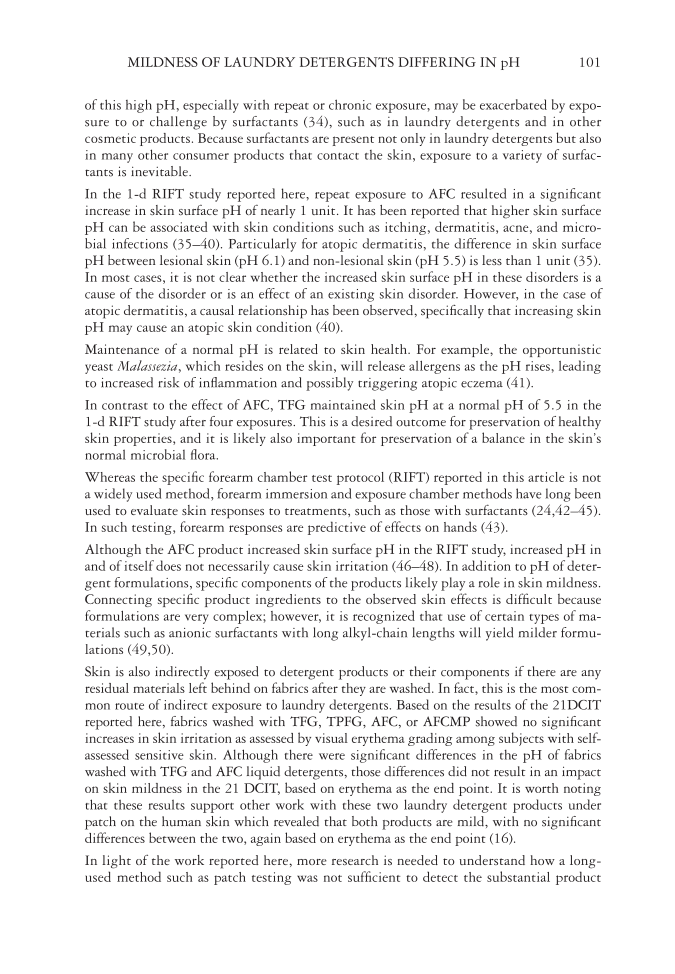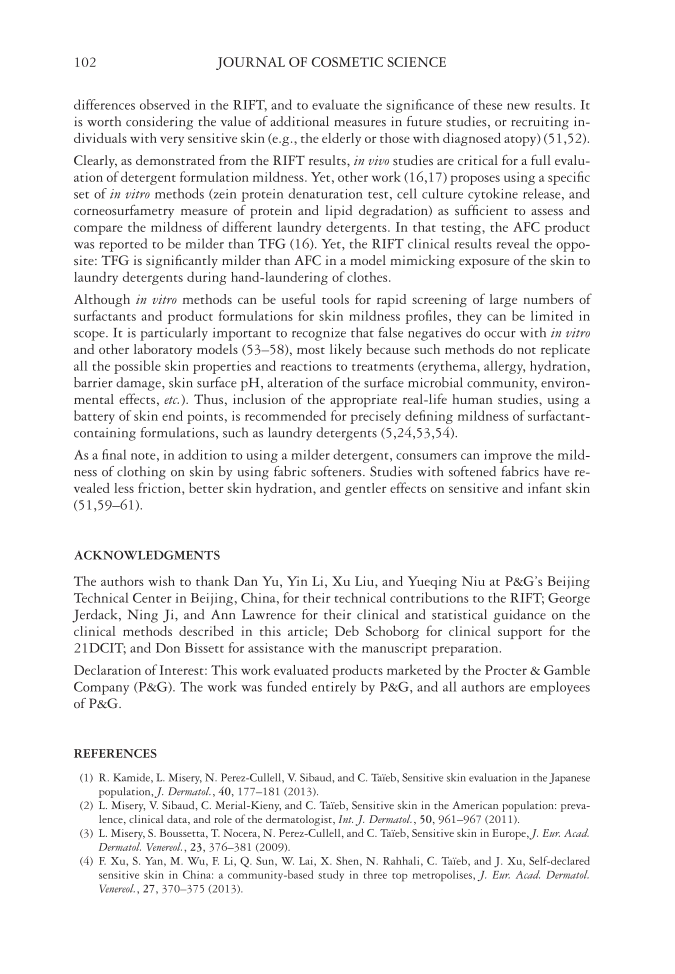MILDNESS OF LAUNDRY DETERGENTS DIFFERING IN pH 101 of this high pH, especially with repeat or chronic exposure, may be exacerbated by expo- sure to or challenge by surfactants (34), such as in laundry detergents and in other cosmetic products. Because surfactants are present not only in laundry detergents but also in many other consumer products that contact the skin, exposure to a variety of surfac- tants is inevitable. In the 1-d RIFT study reported here, repeat exposure to AFC resulted in a signifi cant increase in skin surface pH of nearly 1 unit. It has been reported that higher skin surface pH can be associated with skin conditions such as itching, dermatitis, acne, and micro- bial infections (35–40). Particularly for atopic dermatitis, the difference in skin surface pH between lesional skin (pH 6.1) and non-lesional skin (pH 5.5) is less than 1 unit (35). In most cases, it is not clear whether the increased skin surface pH in these disorders is a cause of the disorder or is an effect of an existing skin disorder. However, in the case of atopic dermatitis, a causal relationship has been observed, specifi cally that increasing skin pH may cause an atopic skin condition (40). Maintenance of a normal pH is related to skin health. For example, the opportunistic yeast Malassezia, which resides on the skin, will release allergens as the pH rises, leading to increased risk of infl ammation and possibly triggering atopic eczema (41). In contrast to the effect of AFC, TFG maintained skin pH at a normal pH of 5.5 in the 1-d RIFT study after four exposures. This is a desired outcome for preservation of healthy skin properties, and it is likely also important for preservation of a balance in the skin’s normal microbial fl ora. Whereas the specifi c forearm chamber test protocol (RIFT) reported in this article is not a widely used method, forearm immersion and exposure chamber methods have long been used to evaluate skin responses to treatments, such as those with surfactants (24,42–45). In such testing, forearm responses are predictive of effects on hands (43). Although the AFC product increased skin surface pH in the RIFT study, increased pH in and of itself does not necessarily cause skin irritation (46–48). In addition to pH of deter- gent formulations, specifi c components of the products likely play a role in skin mildness. Connecting specifi c product ingredients to the observed skin effects is diffi cult because formulations are very complex however, it is recognized that use of certain types of ma- terials such as anionic surfactants with long alkyl-chain lengths will yield milder formu- lations (49,50). Skin is also indirectly exposed to detergent products or their components if there are any residual materials left behind on fabrics after they are washed. In fact, this is the most com- mon route of indirect exposure to laundry detergents. Based on the results of the 21DCIT reported here, fabrics washed with TFG, TPFG, AFC, or AFCMP showed no signifi cant increases in skin irritation as assessed by visual erythema grading among subjects with self- assessed sensitive skin. Although there were signifi cant differences in the pH of fabrics washed with TFG and AFC liquid detergents, those differences did not result in an impact on skin mildness in the 21 DCIT, based on erythema as the end point. It is worth noting that these results support other work with these two laundry detergent products under patch on the human skin which revealed that both products are mild, with no signifi cant differences between the two, again based on erythema as the end point (16). In light of the work reported here, more research is needed to understand how a long- used method such as patch testing was not suffi cient to detect the substantial product
JOURNAL OF COSMETIC SCIENCE 102 differences observed in the RIFT, and to evaluate the signifi cance of these new results. It is worth considering the value of additional measures in future studies, or recruiting in- dividuals with very sensitive skin (e.g., the elderly or those with diagnosed atopy) (51,52). Clearly, as demonstrated from the RIFT results, in vivo studies are critical for a full evalu- ation of detergent formulation mildness. Yet, other work (16,17) proposes using a specifi c set of in vitro methods (zein protein denaturation test, cell culture cytokine release, and corneosurfametry measure of protein and lipid degradation) as suffi cient to assess and compare the mildness of different laundry detergents. In that testing, the AFC product was reported to be milder than TFG (16). Yet, the RIFT clinical results reveal the oppo- site: TFG is signifi cantly milder than AFC in a model mimicking exposure of the skin to laundry detergents during hand-laundering of clothes. Although in vitro methods can be useful tools for rapid screening of large numbers of surfactants and product formulations for skin mildness profi les, they can be limited in scope. It is particularly important to recognize that false negatives do occur with in vitro and other laboratory models (53–58), most likely because such methods do not replicate all the possible skin properties and reactions to treatments (erythema, allergy, hydration, barrier damage, skin surface pH, alteration of the surface microbial community, environ- mental effects, etc.). Thus, inclusion of the appropriate real-life human studies, using a battery of skin end points, is recommended for precisely defi ning mildness of surfactant- containing formulations, such as laundry detergents (5,24,53,54). As a fi nal note, in addition to using a milder detergent, consumers can improve the mild- ness of clothing on skin by using fabric softeners. Studies with softened fabrics have re- vealed less friction, better skin hydration, and gentler effects on sensitive and infant skin (51,59–61). ACKNOWLEDGMENTS The authors wish to thank Dan Yu, Yin Li, Xu Liu, and Yueqing Niu at P&G’s Beijing Technical Center in Beijing, China, for their technical contributions to the RIFT George Jerdack, Ning Ji, and Ann Lawrence for their clinical and statistical guidance on the clinical methods described in this article Deb Schoborg for clinical support for the 21DCIT and Don Bissett for assistance with the manuscript preparation. Declaration of Interest: This work evaluated products marketed by the Procter & Gamble Company (P&G). The work was funded entirely by P&G, and all authors are employees of P&G. REFERENCES (1) R. Kami de, L. Misery, N. Perez-Cullell, V. Sibaud, and C. Taïeb, Sensitive skin evaluation in the Japanese population, J. Dermatol., 40, 177–181 (2013). (2) L. Miser y, V. Sibaud, C. Merial-Kieny, and C. Taïeb, Sensitive skin in the American population: preva- lence, clinical data, and role of the dermatologist, Int. J. Dermatol., 50, 961–967 (2011). (3) L. Misery , S. Boussetta, T. Nocera, N. Perez-Cullell, and C. Taïeb, Sensitive skin in Europe, J. Eur. Acad. Dermatol. Venereol., 23, 376–381 (2009). (4) F. Xu, S. Yan, M. Wu, F. Li, Q. Sun, W. Lai, X. Shen, N. Rahhali, C. Taïeb, and J. Xu, Self-declared sensitive skin in China: a community-based study in three top metropolises, J. Eur. Acad. Dermatol. Venereol., 27, 370–375 (2013).
Purchased for the exclusive use of nofirst nolast (unknown) From: SCC Media Library & Resource Center (library.scconline.org)

















































